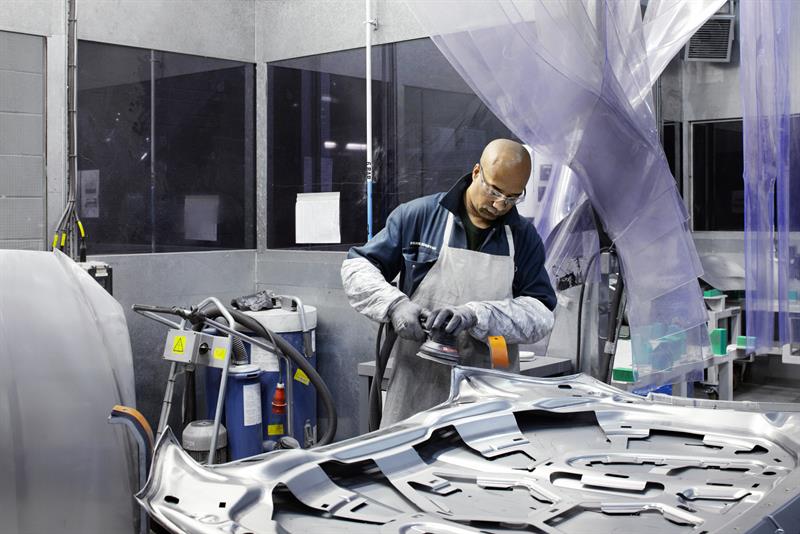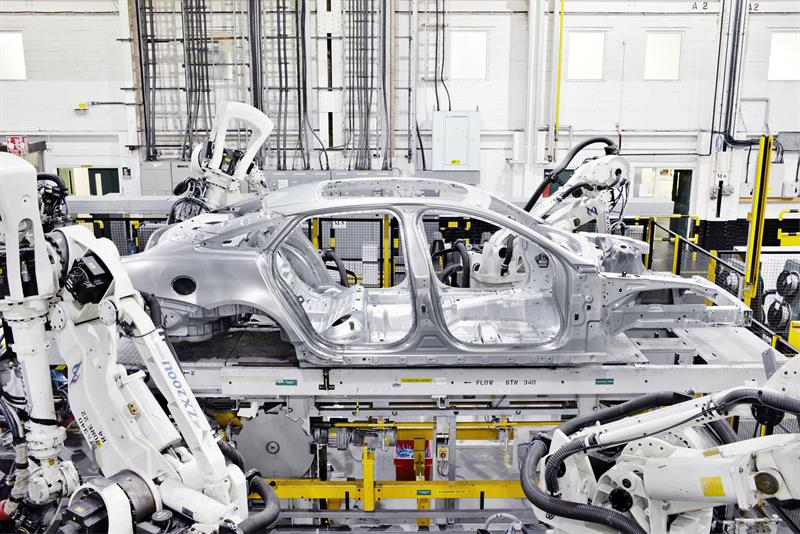Cars, aircraft and trains are increasingly demanding high quality aluminium to bring down in-use emissions. However, with China being the world’s biggest primary aluminium producer, its coal fired power stations are being used for the energy intensive smelting process. It means aluminium’s green credentials in the West come with a dirty secret that’s taking a larger slice of any lifecycle analysis pie chart.
Consumption of aluminium has spiked since the millennium from just under 40 million tonnes to an expected 100 million tonnes or more by 2020. While talk at the Jaguar Land Rover REALCAR event last month was almost exclusively about the circular economy (i.e one that produces less waste by design), it was really about making cleaner aluminium, and securing supply.
The project demonstrates how to take a scrap piece of aluminium, melt it down and make the same alloy. In other words, turn high quality aluminium scrap back into high quality aluminium. Sounds simple enough, but it hasn’t been as straightforward as introducing separate bins and telling staff to be extra vigilant when sorting scrap.
The problem is aluminium is extremely sensitive to cross contamination, meaning that when you mix different alloys, you end up with a metallic jambalaya, something in-between the lowest quality and highest quality material. And then there is steel and other metals, which change the material’s composition considerably and makes end properties difficult to control. Once impurities get into the mix, some are very difficult to get out. It all devalues the waste stream and makes it hard to use recycled aluminium on high quality transport projects.
Control is needed to turn high quality waste scrap back into predictable, homogeneous, high quality aluminium ingots. JLR has done this by introducing a closed loop production system at its three press shops and eight partner shops. From here scrap is collected and re-melted into predictable high quality aluminium ingots, but to do this metallurgists had to develop an entirely new alloy less sensitive to recycled contaminants.
“We’ve optimised an aluminium sheet to make it more tolerant to recycling,” said Adrian Tautscher, a materials engineer at JLR. “The grade of alloy we have developed is RC5754, and it is a mix of processed scrap, prime metal and third party scrap that our partners source. It gives us the same performance as an alloy that relies on much higher prime content.
“It means we don’t have to make a distinction about putting virgin or recycled materials in crash structures or other areas. It is about qualifying the material based on what it will be used for.”
In collaboration with aluminium recycler Novelis and Innovate UK, the project brought together the skills and experience of metallurgists, recyclers, rolling mills, and a number of other key stake holders.
The scale has been the real technical issue. More than £7million has been invested across Jaguar Land Rover’s Halewood, Castle Bromwich and Solihull press shops to install the intricate segregation systems needed to capture the aluminium scrap for re-melting, enabling higher quality and value to be kept in the recycled material. The press shops process thousands of tonnes of material, employ hundreds of staff and create mountains of scrap.

“The target for cross contamination is zero but these are real processes and mixed metal lines so you will get some crossover,” said Andy Doran, Novelis Europe sustainability and recycling development manager. “The target is to eliminate it all together, but we are talking tiny proportions. That is part of the chemistry refinement we have done on the metallurgy side, to allow for any residual crossover – but it is all about minimising it.”
To date around 50,000 tonnes of RC5754 has come back into vehicles, which is designed to contain up to 75% of recycled content, material already being introduced to Jaguar’s XE and XF lines.
REALCAR stands for Recycled Aluminium CAR, but end of life material recovery still remains a challenge for manufacturers
Design light
Like all automotive firms, weight has become the enemy. This is particularly the case for JLR, whose heavier luxury cars struggle more than most to reduce tailpipe emissions. It’s move to aluminium has been industry leading, with Ford closely eyeing progress.
The amount of CO2 equivalent generated from a JLR vehicle is dramatically lower than a decade ago, but looking at the lifecycle of an example vehicle, Tautscher told the audience that, “the use phase is 63% of total emissions produced by a car for 200,000km,” which is down from 70%.
“As we lightweight more intensely,” he continued, “the materials production phase has grown to 27% from 20%.”
Though the lifecycle analysis points to an overall CO2 reduction over the last decade, the increased use of aluminium is having some cause for concern from supply and price, as well as production, points of view.
While the use of secondary aluminium certainly ticks the environmental box, with recycled material requiring just 5% of the energy needed to smelt primary material, it also benefits JLR in other ways.
“This is being used for strategic engineering purposes,” added Tautscher. “This is not just an LCA or CSR activity.”
The reality is that aluminium has historically been one of the front runners in what is termed the circular economy. Recovery of the material is estimated to be 90%, only exceeded by glass at 94%.
It’s claimed three quarters of the aluminium ever produced is still in productive use, and as long as the material is kept clean and segregated it is in theory infinitely recyclable. The key thing is eliminating contaminants at source, so these don’t need to be diluted down later on with more prime material.

However, aside from devaluing material quality and waste streams – and making it unusable for many – there are very real concerns about security of supply. JLR is the UK’s largest automotive manufacturer and produces in excess of 500,000 vehicles a year. As volumes continue to rise and new models introduced, forming a business strategy with aluminium at its heart must address these concerns, and to a large degree this is just what the REALCAR project is about.
Rocketing demand coming from the building and construction sector – particularly in Asia – as well booming global demand for efficient transport means aluminium is the lightweight material of choice as it occupies the Goldilocks territory between steels’ ease of manufacture and carbon fibre’s lighter weight.
Conservative estimates predict that much of the global demand for aluminium is going to be met by primary sources. The worry is that supply is going to come under increasing pressure and the markets renowned price volatility – already considered a headache by purchasing managers – will only get worse.
End of Life?
Despite the accolades from industry supporters, from an industry commentators point of view you might have expected more. Taking clean scrap, melting it down, and reforming it to be used again as principally the same material, should surely be happening anyway. The real breakthrough, and the question of everyone’s lips was, ‘what about end of life vehicles?’ Surely, this is where the loop really needs to be closed, if we are really to achieve a circular economy?
“It was challenging enough to do what we did,” explained Tautscher. “The even bigger challenge is to look at [End of Life] and longer term that is what we want to get to. That’s the only way we are going to achieve higher recycling rates, by looking at these post consumer sources.”
For many though this is going to require a fundamental shift by the global aluminium industry. Instead of the thousands of different compositions that are currently available, a more limited selection of alloys is surely advantageous to avoid troublesome impurities seeping in, and devaluing the recycled materials.
REALCAR does set a foundation and there are more projects to build upon this work, with end of life remaining the ultimate destination. However, for now, REALCAR is less of a breakthrough, and more of a milestone. ‘Real develop’ remains someway off.
| Aluminuim problems Global recovery of the material is estimated to be 90%, only exceeded by glass at 94%. It's claimed three quarters of the aluminuim ever produced is still in productive use. As long as the material is kept clean and segregated, it is in theory infinitely recyclable. The key thing is eliminating contaminants at source, so they don't the recycled material's quality and make it unusable for industries that require a high level of material quality. While poorer recycled materials can be diluted with more prime material to improve and hone properties, it defeats the point of trying to move away from prime material in the first place. And, for some contaminants like zinc, once they are in a batch of aluminuim, they are almost impossible to remove. |





